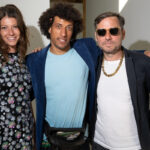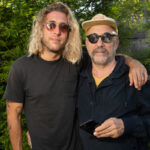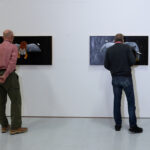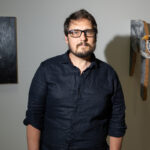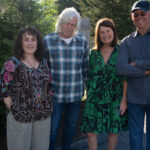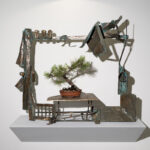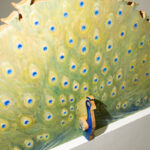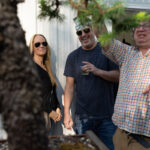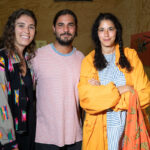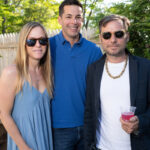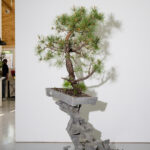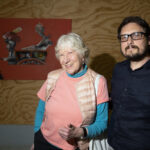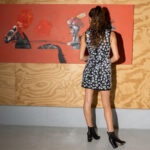Photo Credit: Lori Hawkins, courtesy of Tripoli Gallery, © Tripoli Gallery Inc., 2022
TRIPOLI GALLERY
26 Ardsley Road, Wainscott, NY 11975
T. 631 377 3715
Hours: 10am–6pm, Sunday 12–5pm, Closed Tuesday
Wainscott, NY–Tripoli Gallery is pleased to present Found Life, its second solo exhibition with Brooklyn based artist Benjamin Keating. On view from May 28th through June 27th, 2022, there will be an opening reception for the Artists on Sunday, May 29th from 5–7pm at Tripoli Gallery in Wainscott, NY.
“In my neighborhood there is a tree I pass on my way to the park that has grown over the metal bars someone erected around it years ago. The metal bars were set there for protection, I suspect, but from what, I’m unsure. It’s the only tree with its own fence on the block. It’s not that the posts have penetrated the tree; the tree has absorbed the metal. The wood flows around it. This doesn’t seem to have unsettled the tree. Each spring its leaves are abundant. I wonder how long before the container becomes the thing contained?“–Charlie Shultz
The relationship of the vessel to its volume is fundamental, but when the vessel holds a tree the balance of the interaction becomes more complex. The tree either outgrows its container, or the tree is pruned sufficiently to dwarf its growth and maintain an equilibrium. In other words, the relationship is not static, but dynamic, and it’s compelled by the conditions of the environment, which may be both natural (sun & rain) and cultural (clippers & saws). That the materials can be influenced, molded, encouraged to respond to the hand of the artist means that this relationship can be a sculptural one, and for Ben Keating, it is.
If there are two materials Keating understands with intuitive clarity, they would be molten metal and fertile soil. Keating is a person who operates a foundry and tends a garden; who teaches others how to work in the foundry and whose garden feeds his neighbors; who rescues saplings he finds covered in plastic, and a person whose home is the sum of what he’s built. When Keating talks about the fires of his furnace as he handles the delicate new buds on a tree that is more than two centuries old, you hear the kind of passion that only comes from a heady mixture of deep knowledge and limitless curiosity—a combination that rejuvenates itself endlessly.
In Found Life, Keating instinctively combines different species of trees with different types of metals. Like precious stones, the small trees are set in sculptures of containers. In one, the soft organic texture of a mossy mound at the base of the tree is accentuated by the shine of aluminum that surrounds it. In another we are transfixed by the way the sculpted metal frames a small pine. Resulting in a discovery and a surprise, Keating’s recent body of work feels cohesive and interconnected as it simultaneously achieves tremendous variety.
Some of the forms Keating casts are domestic—a pair of old sneakers, now bronze—but mostly he is piecing together crude shapes to create different structures of ranging complexity. How these shapes correspond and establish a sense of balance with the verticality of the tree is a measure of Keating’s material intelligence and aesthetic sensibility. In a sense then, the natural world is Keating’s collaborator, for its energies are responsible for the tree’s very being, and by extension those energies imbue the sculpture. Because Keating is working with something that lives, his sculpture requires attention, care, and—importantly—being touched. To create a work of art that compels an obligation to conservation is to instill it with an intimacy that is needed in this day and age. It pushes against the basic expectations of contemporary art even as it aligns itself with the values from which much contemporary art has emerged. It is radical work, forged in fire, grown by the sun, and to be nurtured by the hands of one who will cherish it.
Benjamin Keating (b. 1977, Brooklyn, NY) has been commissioned by noteworthy artists and has exhibited throughout New York; in group shows at Paul Kasmin Gallery, in a Brooklyn Rail auction at Pace Gallery and alongside some of the great artists at the Mana Contemporary in Jersey City, NJ, where his metal-casting facility is based. Keating has exhibited with Tripoli Gallery since 2015 and had his first solo exhibition with the gallery in 2017. His work can be found in notable collectors’ and artists’ homes. Keating is based in Brooklyn and Jersey City.
—
Tripoli Gallery is pleased to present a solo presentation of new paintings by Miles Partington titled Tam Lin. On view from May 28th through June 29th, 2022, the opening reception will take place on Sunday, May 29th from 5–7pm at Tripoli Gallery in Wainscott, NY.
To experience Miles Partington’s work, is to enter a world that is as timeless as it is rooted in the present. Animals, his ever present subjects, are ubiquitous and anthropomorphic. His imagination emerges through his fingertips, whether sculpting or painting. Medieval knights are bisected by an unknown horizon line, melting away into the background of the canvas. There is a joust between two paintings, only evident by the lances their subjects yield, that break the edge of one canvas, only to be continued on another. In Tam Lin, it’s impossible to question the world present. It is so thoughtful and well executed, that it is believable. Why can’t an owl ride on the back of a horse? The horse’s body glistens as if after a long run, and an owl sits atop its back, solemn, unyielding, the moon behind its head, a halo.
The animal kingdom is much different from our own—outside of the urban city centers, unruly, not manicured. But Partington’s animal kingdom is somehow welcoming even if fantastical. The work in Tam Lin almost exudes a childlike wonder, if only it weren’t so well crafted. There is a strangeness and a precision to the paintings and sculptural forms that come with a skilled hand, repetition, practice, and even trial and error. In Seaford, Long Island, Seamans Neck Park not far from the Atlantic Ocean, is home to hundreds of beautiful emerald green Monk parakeets. The birds are native to South America, and it isn’t officially known how they ended up on the South Shore of Long Island, surviving and thriving. Seeing the birds fly from branch to park lights, perching high above the reach of children below, is surreal, but akin to Partington’s vision, that which is as likely as it is impossible.
Paint is applied to the surface with the utmost care and intention, Partington relies on representation mixed with the fantastical. His proportions, in one case a figure hiding behind an elephant on a farm, are incongruous but in the best way. The figure identified wearing a hat, has his arm around the neck of the elephant which appears quite small in comparison. The gesture is loving if not concealing, as parrots with red and blue wings outstretched, fly above in an early morning sky. A nearby building in this particular painting (After Unknown Artist, 2022), has dark brown paneling, and a pointed green roof, not unlike the barn where Partington has his Southampton studio. In the same place where peacocks, elephants, toucans, and knights roam, there is an artist waiting to bring his visions to life.
Looking at historical paintings by Delacroix, George Stubbs, Théodore Géricault, and Pieter Boel, Partington took liberties loosely referencing Lady Godiva and Joan of Arc, introducing them to a timeline all his own (including one of the heroines donning a shirt that features musician Patti Smith!). The title, Tam Lin, was derived from Scottish folklore about a mythical man, part fae, who wooed young maidens after they’d picked roses he declared to be his. Early versions of the story often in song, stem from 1549, and tell a tale similar to that of the Pied Piper. The story is said to have a moralistic component, warning humans of what could happen should they lay eyes on a fairy. It is a warning as much as it is a dream, an excuse to explore the unknown…never knowing what lurks between fantasy and reality.




